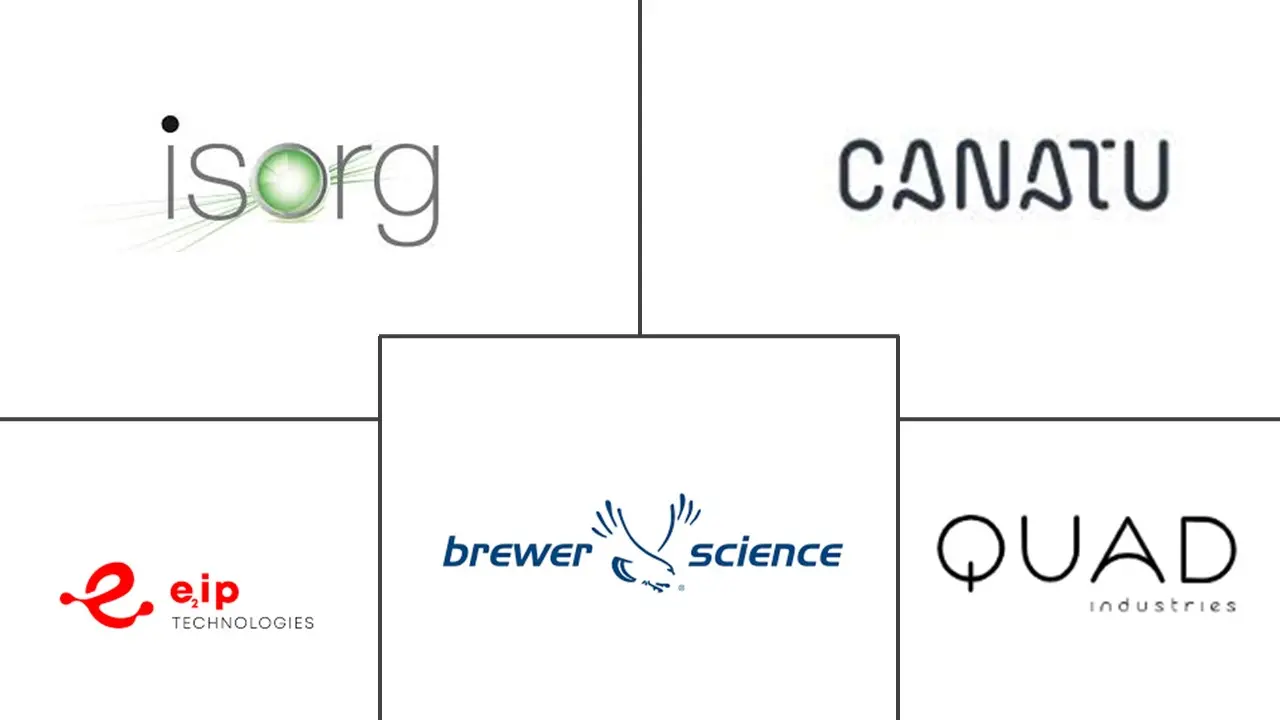Printed Flexible Sensor Market Size and Share
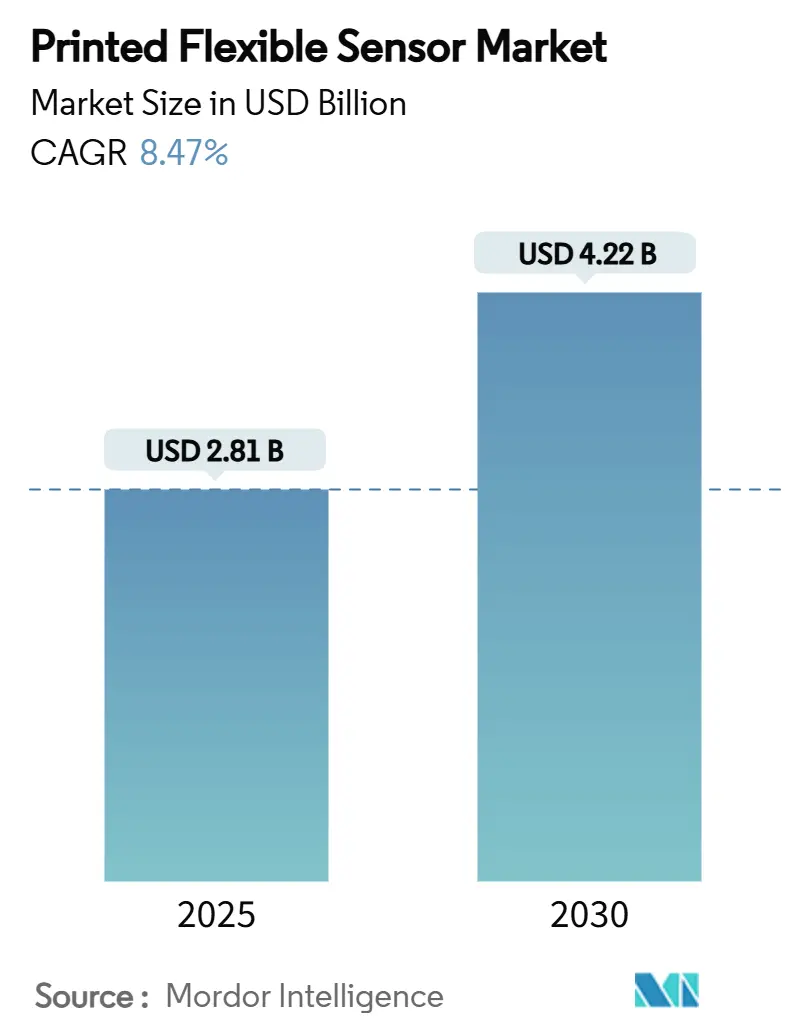
Printed Flexible Sensor Market Analysis by Mordor Intelligence
The printed flexible sensor market size is valued at USD 2.81 billion in 2025 and is forecast to reach USD 4.22 billion by 2030, reflecting an 8.47% CAGR over the period. This steady expansion results from converging advances in roll-to-roll additive manufacturing, policy incentives supporting domestic semiconductor capacity, and rising demand for conformable sensing solutions across consumer electronics, medical wearables, automotive systems, and defense platforms. Cost optimization remains a pivotal growth lever as new printing processes shave more than 40% from capital expenditure outlays, thereby lowering entry barriers for both incumbents and start-ups. Government programs such as the Biden–Harris Administration’s USD 1.6 billion allocation for advanced packaging underscore the strategic relevance of flexible electronics infrastructure.[1]NIST, "Biden-Harris Administration to Invest Up to USD 1.6 Billion to Establish and Accelerate Domestic Capacity for Semiconductor Advanced Packaging," nist.govAsia-Pacific’s scale advantage, particularly in flexible OLED capacity build-out, positions the region to supply nearly half of all printed sensors by 2030, while regulatory moves in Europe foster demand for recyclable sensor architectures.
Key Report Takeaways
- By sensor type, pressure sensors led with 28.4% of printed flexible sensor market share in 2024, whereas biosensors are poised for the highest CAGR at 9.2% through 2030.
- By printing technology, screen printing held 36.1% revenue share in 2024, while inkjet printing is projected to advance at an 8.9% CAGR to 2030.
- By substrate, PET captured 42.0% share of the printed flexible sensor market size in 2024; paper and cellulose substrates are expanding at a 9.3% CAGR to 2030.
- By end-user industry, consumer electronics accounted for 41.5% of printed flexible sensor market size in 2024; medical and healthcare applications are accelerating at a 9.4% CAGR through 2030.
- By geography, Asia-Pacific dominated with 46.9% printed flexible sensor market share in 2024 and is set to maintain the fastest regional CAGR of 8.8% through 2030.
Global Printed Flexible Sensor Market Trends and Insights
Drivers Impact Analysis
| Driver | (~) % Impact on CAGR Forecast | Geographic Relevance | Impact Timeline |
|---|---|---|---|
| Rising demand for energy-efficient, ultra-thin consumer electronics | +1.8% | Global; concentrated in APAC manufacturing hubs | Medium term (2-4 years) |
| Increasing adoption in medical wearables and biosensing | +2.1% | North America & EU adoption; APAC manufacturing | Long term (≥ 4 years) |
| Automotive in-cabin HMI and battery monitoring integration | +1.4% | Global; early roll-outs in premium vehicle lines | Medium term (2-4 years) |
| Defense R&D for conformal avionics and structural health monitoring | +0.9% | North America & EU with spillover to allies | Long term (≥ 4 years) |
| Roll-to-roll additive manufacturing cutting CapEx > 40% | +1.6% | Global; rapid uptake in established fabs | Short term (≤ 2 years) |
| EU eco-design policies favoring recyclable printed sensors | +0.7% | EU primary; regulatory diffusion worldwide | Long term (≥ 4 years) |
| Source: Mordor Intelligence | |||
Rising Demand for Energy-Efficient, Ultra-Thin Consumer Electronics
Smartphone and wearable OEMs embed printed flexible sensors to deliver foldable displays and pressure-sensitive housings that conventional rigid components cannot support. Ultra-low-power architectures extend device battery life, meeting user expectations for energy efficiency while enabling slim form factors. Research at Penn State produced self-assembling conductive networks that remove secondary activation steps, trimming manufacturing energy budgets. Gaming peripherals increasingly rely on pressure-mapped surfaces, widening the printed flexible sensor market beyond mobile hardware. The same thin, bendable films are migrating into industrial monitoring where sensors must conform to curved equipment without adding bulk.
Increasing Adoption in Medical Wearables and Biosensing
Healthcare providers deploy printed biosensors for real-time vital-sign tracking, accelerating the shift toward preventive, remote care. Covestro’s partnership with accensors yielded breathable, skin-friendly patch sensors that leverage Baymedix adhesives and Platilon TPU films. The Korea Institute of Materials Science demonstrated ammonia-gas detectors with 1 ppm sensitivity, opening non-invasive diagnostics for renal disease monitoring. [2]Korea Institute of Materials Science, "Flexible Ammonia Sensor Detects Gas with Ultra-Sensitivity and Low Cost," phys.org Regulatory pathways are streamlining as flexible devices build clinical evidence, positioning biosensors to capture the fastest growth trajectory within the printed flexible sensor market.
Automotive In-Cabin HMI and Battery Monitoring Integration
Premium vehicle programs incorporate printed pressure and touch matrices into steering wheels and seats, creating intuitive HMIs while logging driver-state data. Battery-electric platforms adopt temperature and pressure films to surveil cell health, potentially trimming USD 3,000 per vehicle in warranty servicing costs. Joyson Safety Systems’ alliance with Forciot to co-develop printed steering-wheel sensors illustrates the scale-up path from prototype to series production. As autonomous capability rises, OEMs view flexible sensors as cost-effective routes to embed redundancy without mechanically intrusive hardware.
Defense R&D for Conformal Avionics and Structural Health Monitoring
NextFlex channeled USD 39.5 million into programs that integrate flexible hybrid electronics onto airframes, enabling stress-mapping across curved fuselage sections. Aerospace contractors use thin ribbon electronics to track strain in flight, feeding predictive-maintenance analytics that lift airframe utilization rates. Embraer’s E2 test program showcases AI-enabled structural telemetry, validating printed sensors under operational loads.
Restraints Impact Analysis
| Restraint | (~) % Impact on CAGR Forecast | Geographic Relevance | Impact Timeline |
|---|---|---|---|
| Accuracy and stability gap vs. silicon sensors | -1.9% | Global; acute in precision-critical use-cases | Medium term (2-4 years) |
| Lack of fabrication standardization | -1.2% | Global; uneven standards uptake | Long term (≥ 4 years) |
| Volatile supply of silver nanoparticle inks | -0.8% | Global; supply chain heavily APAC-centric | Short term (≤ 2 years) |
| Limited reliability data for high-temperature use-cases | -0.6% | Aerospace, automotive, industrial clusters | Long term (≥ 4 years) |
| Source: Mordor Intelligence | |||
Accuracy and Stability Gap vs. Silicon Sensors
Printed gauges still trail micro-machined silicon alternatives on long-term stability, especially when exposed to temperature swings or mechanical fatigue. Microcrystalline silicon devices achieve gauge factors of 31 with minimal drift, whereas printed films can deviate beyond acceptable thresholds in precision-critical deployments. Clinical evaluations report accuracy spreads of 88–94% for flexible pressure sensors, sufficient for indicative monitoring yet below invasive-grade benchmarks. Ongoing research into encapsulation layers and nanocomposite inks seeks to narrow the performance delta.
Lack of Fabrication Standardization
IPC-4591A and IPC-2292 establish guidelines for conductive materials and design rules, but uneven adoption across print shops fosters variability in resistance, adhesion, and layer alignment.[3]IPC, "IPC Standards for Printed Electronics," ipc.orgDivergent curing regimes between screen and inkjet lines compound the issue, forcing OEMs to validate each supplier independently, thereby inflating qualification timelines and cost. Industry consortia are advocating common test coupons and metrology metrics as prerequisites for scaling the printed flexible sensor industry.
Segment Analysis
By Sensor Type: Biosensors Lead Innovation Wave
Printed pressure sensors controlled 28.4% of the overall printed flexible sensor market share in 2024, supplying haptic interfaces to smartphones, gaming controllers, and automotive touch-surfaces. Parallel momentum in biosensors, expanding at a 9.2% CAGR, reflects healthcare’s drive toward non-invasive, always-on patient monitoring. The biosensor surge widens the printed flexible sensor market as diagnostics migrate from clinic to consumer spheres. Robust demand intersects with AI-enabled analytics, where high-resolution strain gauges map biomechanics for rehabilitation feedback loops. Furthermore, gas sensors detecting 1 ppm ammonia open agricultural and environmental-health use-cases, illustrating portfolio diversification within the printed flexible sensor industry.
Market adjacencies amplify differentiation: photodetectors for smart packaging authenticate freshness, while strain sensors woven into e-textiles capture ergonomic metrics for industrial safety programs. The printed flexible sensor market size for biosensors is forecast to outgrow legacy segments as polymer substrates coupled with nano-engineered inks deliver clinically relevant sensitivity without sacrificing wearer comfort. Intensifying R&D in enzyme-functionalized electrodes and self-healing conductors will likely sustain the segment’s outperformance against conventional pressure and temperature counterparts.

Note: Segment shares of all individual segments available upon report purchase
By Printing Technology: Inkjet Printing Gains Precision Edge
Screen printing retained 36.1% revenue in 2024 thanks to its thick-film capability and low-unit cost, but inkjet printing’s anticipated 8.9% CAGR underscores industry migration toward higher pattern resolution and multi-material flexibility. As line widths approach the sub-20 µm threshold, inkjet platforms enable dense routing on limited real-estate, thereby advancing miniaturization roadmaps within the printed flexible sensor market. Emergent aerosol-jet and 3D printing modalities further extend the design envelope by depositing conductive pastes on non-planar geometries, a requirement for conformal avionics and medical implants.
Gravure and flexographic lines remain staples for million-unit consumer-electronics volumes, yet inkjet’s digital nature curtails changeover time, permitting mass-customization of sensor layouts. Capillary-flow printing of submicron CNT transistors demonstrated by academic groups showcases feature parity with photolithography, marking a decisive competitive inflection. The printed flexible sensor market size tied to inkjet systems is projected to accelerate as ink suppliers commercialize oxide-free copper nanofluids that sinter via photonic flashes, achieving bulk-silver conductivities without the precious-metal price drag.
By Substrate Material: Paper and Cellulose Emerge as Sustainable Alternative
PET captured 42.0% of printed flexible sensor market size in 2024 due to its proven mechanical stability and chemical resilience. However, paper and cellulose substrates, forecast to expand at 9.3% CAGR, epitomize the sector’s pivot toward eco-design compliance. Fully recyclable ECG patches fabricated from nanocellulose and carbon conductors validate functional parity with PET devices while enabling circular end-of-life pathways.
Polyimide retains incumbency in high-temperature environments where printed flexible sensor market demand stems from battery module monitoring and aircraft engine diagnostics. PEN’s barrier properties position it for moisture-sensitive pharma-packaging sensors. Glass and metal-foil laminates serve microwave-frequency or >300 °C niches. The ongoing refinement of cellulose-compatible conductive inks addresses ink absorption and roughness challenges, broadening sustainable substrate adoption across the printed flexible sensor industry.
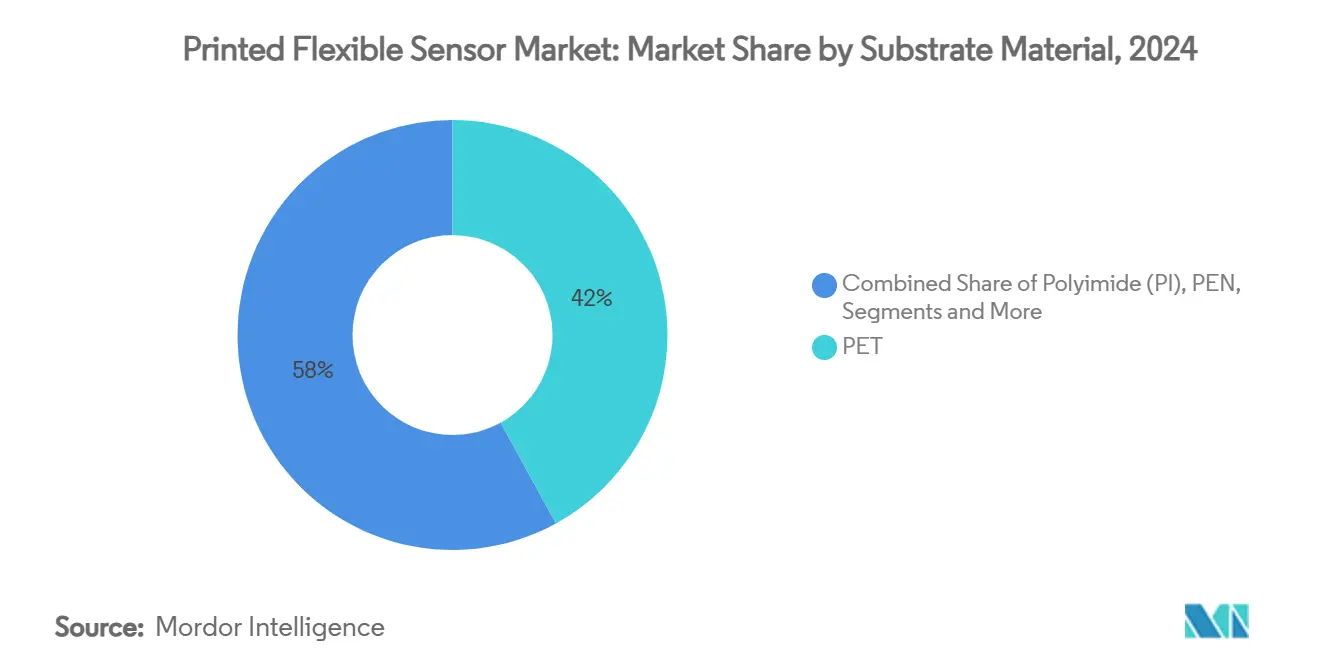
Note: Segment shares of all individual segments available upon report purchase
By End-User Industry: Medical Sector Drives Premium Applications
Consumer electronics generated 41.5% of printed flexible sensor market size in 2024 as foldable phones, VR headsets, and smartwatches embedded tactile and environmental sensing. Medical and healthcare customers, expanding at 9.4% CAGR, assign premium valuations to continuous monitoring patches and implantable biosensors that lower hospital-readmission rates. Reimbursement shifts toward outcome-based care heighten demand for accurate, disposable sensors that integrate effortlessly with telehealth platforms.
In automotive domains, electrification and autonomy raise sensor density requirements for both propulsion and cabin-experience modules. Industrial automation uses thin films to retrofit legacy machinery with predictive-maintenance telemetry without downtime. Aerospace and defense procurements favor printed flexible sensor solutions that conform to weight and form-factor constraints, despite lower volumes. Smart packaging, cataloged under industrial use-cases, exploits photodetectors and gas sensors to secure cold-chain integrity, offering brands traceability enhancements that justify sensor chip costs.
Geography Analysis
Asia-Pacific held 46.9% printed flexible sensor market share in 2024 and is anticipated to grow at 8.8% CAGR to 2030. China leads capacity additions, with BOE projected to surpass Samsung Display in flexible OLED throughput by 2028, a development that secures upstream material demand and localizes printed sensor supply chains. Japan’s precision-manufacturing heritage and South Korea’s material-science depth add regional resilience, while Southeast Asian economies provide cost-efficient assembly for high-volume consumer electronics.
North America ranks second by revenue. Federal incentives such as the USD 1.6 billion advanced packaging program and the USD 179 million DOE microelectronics centers stimulate domestic printed flexible sensor industry capability. Defense budgets catalyze early adoption of conformal avionics sensors, and the robust medical-device ecosystem accelerates biosensor commercialization.
Europe leverages automotive leadership and stringent eco-design mandates to shape global specifications for recyclable sensors. The Reform Project’s initiative to forge a regional functional electronics supply chain reduces reliance on Asian imports and channels R&D funding toward sustainable substrate technologies. [4]Reform Project, "European Functional Electronics Supply Chain Initiative," reform-project.eu Latin America and the Middle East & Africa currently command small shares, yet industrial modernization and telecom infrastructure upgrades signal latent demand, particularly in smart-grid and building-automation sensing.
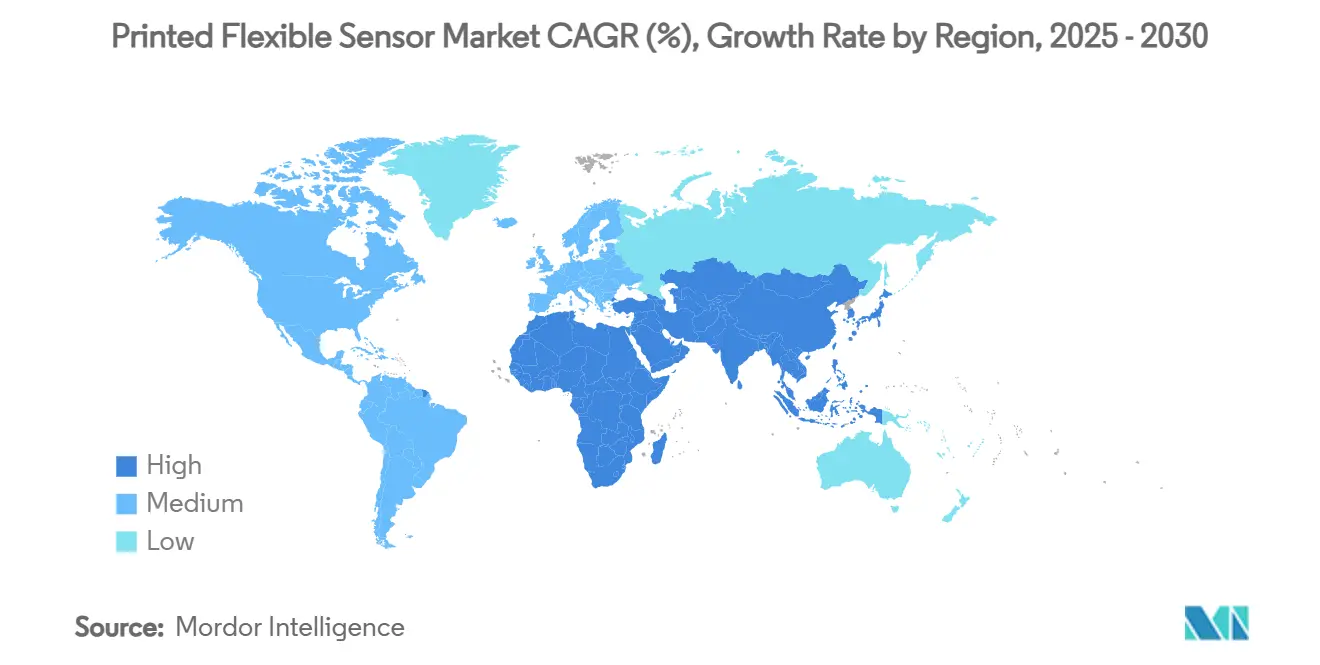
Competitive Landscape
The printed flexible sensor market is moderately fragmented. Electronics conglomerates such as 3M, Molex, and TDK leverage capital depth to scale production lines, while specialist firms like Canatu and ISORG focus on niche materials and device architectures. Partnership ecosystems increasingly pair materials innovators with tier-one component suppliers, accelerating time-to-market and de-risking scale-up. The Joyson Safety Systems–Forciot collaboration exemplifies synergy between an incumbent automotive-safety supplier and a printed-electronics start-up, pooling design IP and vehicle-certification know-how.
Technology roadmaps emphasize vertical integration from conductive-ink synthesis through substrate coating to module assembly, securing IP moats and guaranteeing supply stability amid raw-material volatility. Patent filings center on nano-ink formulations, hybrid rigid-flex assemblies, and self-healing conductor networks, underscoring innovation intensity. Competitive pressures further escalate as roll-to-roll lines reach commercialization, narrowing cost differentials versus incumbent sensor technologies and inviting price-based competition on high-volume consumer applications.
M&A activity remains selective, prioritizing bolt-on acquisitions of ink chemistries or process-control software rather than headline-grabbing consolidations. As reliability data matures, high-temperature aerospace and industrial sectors may spur clustering around a handful of qualified suppliers, subtly nudging the market toward higher concentration over the long term.
Printed Flexible Sensor Industry Leaders
-
Canatu Oy
-
Brewer Science
-
ISORG
-
E2IP Technologies
-
Quad Industries
- *Disclaimer: Major Players sorted in no particular order
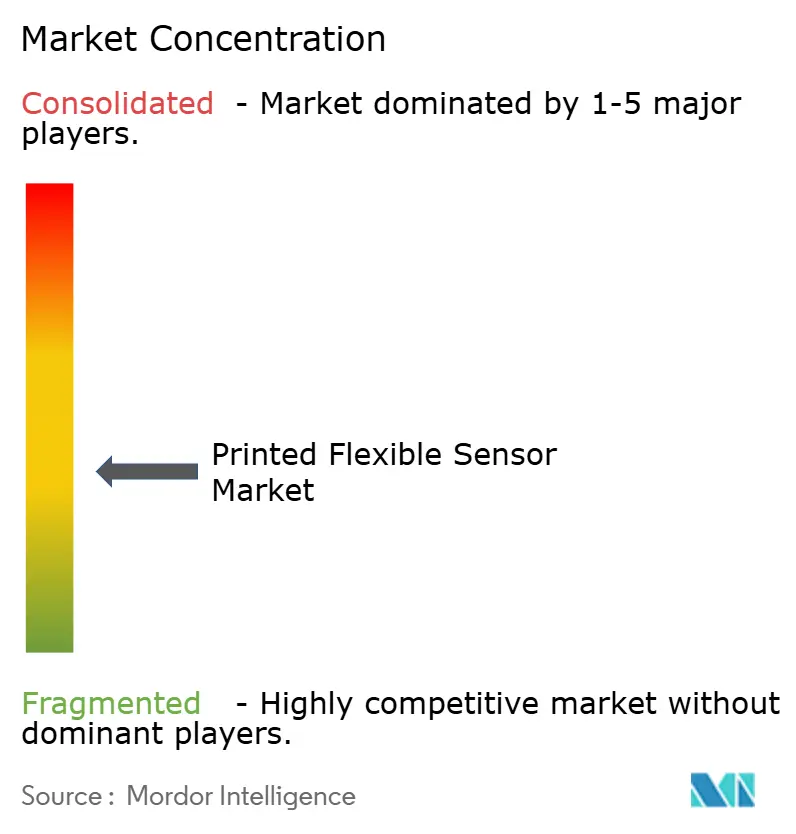
Recent Industry Developments
- February 2025: 3M joined the US-JOINT Consortium, opening a Silicon Valley R&D hub to strengthen semiconductor material innovation and secure a pipeline for high-performance sensor substrates.
- January 2025: The U.S. DOE awarded USD 179 million to three Microelectronics Science Research Centers, advancing energy-efficient microelectronics for extreme environments applicable to high-temperature flexible sensors.
- October 2024: Joyson Safety Systems and Forciot entered a development pact for printed steering-wheel sensors, bolstering automotive HMI differentiation.
- September 2024: Canatu shipped its first S-100 CNT reactor to a semiconductor client, scaling carbon-nanotube-based sensor electrode production.
Global Printed Flexible Sensor Market Report Scope
Sensors that are printed on flexible substrates signify a growing market. While some may consist of a very simple structure with only a few electrodes, others are much more complicated and need the deposition of many layers. They have in common the ability to be printed on plastic substrates, which offers them benefits in terms of mechanical flexibility, thinness, and weight decrease.
The printed flexible sensor market is segmented by type (biosensor, touch sensor, photodetectors, temperature sensor, pressure sensor, and other types), end-user industry (automotive, consumer electronics, medical and healthcare, defense and aerospace, and other end-user industries), and geography (North America, Europe, Asia-Pacific, Latin America, and the Middle East and Africa). The report offers the market sizes and forecasts for all the above segments in value terms (USD).
| Biosensors |
| Touch Sensors |
| Photodetectors |
| Temperature Sensors |
| Pressure Sensors |
| Gas Sensors |
| Strain and Force Sensors |
| Screen Printing |
| Inkjet Printing |
| Gravure Printing |
| Flexographic Printing |
| 3D / Aerosol-Jet Printing |
| Polyimide (PI) |
| PET |
| PEN |
| Paper and Cellulose |
| Others (Glass, Metal Foils) |
| Consumer Electronics |
| Medical and Healthcare |
| Automotive |
| Industrial and Manufacturing |
| Aerospace and Defense |
| Others (Smart Packaging, Building Automation) |
| North America | United States | |
| Canada | ||
| Mexico | ||
| South America | Brazil | |
| Argentina | ||
| Rest of South America | ||
| Europe | Germany | |
| France | ||
| United Kingdom | ||
| Italy | ||
| Spain | ||
| Russia | ||
| Rest of Europe | ||
| Asia Pacific | China | |
| Japan | ||
| South Korea | ||
| India | ||
| Australia and New Zealand | ||
| Southeast Asia | ||
| Rest of Asia Pacific | ||
| Middle East and Africa | Middle East | Saudi Arabia |
| UAE | ||
| Turkey | ||
| Rest of Middle East | ||
| Africa | South Africa | |
| Nigeria | ||
| Rest of Africa | ||
| By Sensor Type | Biosensors | ||
| Touch Sensors | |||
| Photodetectors | |||
| Temperature Sensors | |||
| Pressure Sensors | |||
| Gas Sensors | |||
| Strain and Force Sensors | |||
| By Printing Technology | Screen Printing | ||
| Inkjet Printing | |||
| Gravure Printing | |||
| Flexographic Printing | |||
| 3D / Aerosol-Jet Printing | |||
| By Substrate Material | Polyimide (PI) | ||
| PET | |||
| PEN | |||
| Paper and Cellulose | |||
| Others (Glass, Metal Foils) | |||
| By End-user Industry | Consumer Electronics | ||
| Medical and Healthcare | |||
| Automotive | |||
| Industrial and Manufacturing | |||
| Aerospace and Defense | |||
| Others (Smart Packaging, Building Automation) | |||
| By Geography | North America | United States | |
| Canada | |||
| Mexico | |||
| South America | Brazil | ||
| Argentina | |||
| Rest of South America | |||
| Europe | Germany | ||
| France | |||
| United Kingdom | |||
| Italy | |||
| Spain | |||
| Russia | |||
| Rest of Europe | |||
| Asia Pacific | China | ||
| Japan | |||
| South Korea | |||
| India | |||
| Australia and New Zealand | |||
| Southeast Asia | |||
| Rest of Asia Pacific | |||
| Middle East and Africa | Middle East | Saudi Arabia | |
| UAE | |||
| Turkey | |||
| Rest of Middle East | |||
| Africa | South Africa | ||
| Nigeria | |||
| Rest of Africa | |||
Key Questions Answered in the Report
What is the printed flexible sensor market growth outlook to 2030?
The printed flexible sensor market is projected to climb from USD 2.81 billion in 2025 to USD 4.22 billion by 2030, yielding an 8.47% CAGR.
Which region leads the printed flexible sensor market today?
Asia-Pacific controls 46.9% of 2024 revenue and is forecast to maintain the highest regional CAGR of 8.8% through 2030 thanks to large-scale OLED and semiconductor investments.
Why are biosensors growing faster than other sensor types?
Healthcare digitization, remote patient monitoring mandates, and material advances enabling skin-friendly patches drive biosensors at a 9.2% CAGR, outpacing pressure and temperature segments.
How do roll-to-roll processes influence market competitiveness?
Roll-to-roll additive manufacturing cuts capex by more than 40%, slashing entry barriers and accelerating mass-production scaling, thereby intensifying competition among incumbent and emerging suppliers.
What core challenge limits adoption in aerospace applications?
Reliability at >200 °C remains insufficiently documented; printed sensors still trail silicon devices on long-term stability, constraining uptake in high-temperature aerospace and industrial contexts.
Which printing technology is gaining prominence?
Inkjet printing is expanding at an 8.9% CAGR as its high-resolution, multi-material flexibility supports miniaturized and customized sensor designs that screen printing cannot easily match.
Page last updated on:
